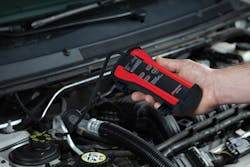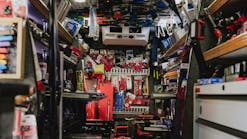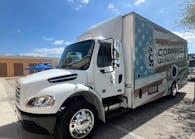A primer on air conditioning service: what to know about changes in refrigerant and tooling
While a seasonal opportunity for most shops, the HVAC system has become an integral part of any vehicle on the road today.
Like most vehicles on the road, technology is forever changing.
This article covers updates in regulations with refrigerants, specifically changes to industry usage of R-1234yf refrigerant.
Regulations and changes
Vehicles on the road today will primarily have R-134a refrigerant. However, OEs have begun to adopt use of a new refrigerant, R-1234yf, in response to the impact of refrigerants on the environment.
While carbon dioxide was the refrigerant of choice during the early 20th century, it was later replaced with synthetic chemicals. Although carbon dioxide is a global-warming gas, conventional refrigerants, called hydrofluorocarbons, cause about 2,000 times more global warming than the same quantity of carbon dioxide.
The adoption of R-1234yf refrigerant began with regulations adopted in European countries. While no regulations have yet been set in the U.S., automotive manufacturers are beginning to adopt the use of R-1234yf refrigerant for late model vehicles. This is because the government has set up CAFÉ (Corporate Average Fuel Economy) standards that provide credit for using a refrigerant that’s seen to have a lesser impact on global warming.
European standards used a comparison of Global Warming Potential (GWP) to determine the efficiency and global impact of a refrigerant on the atmosphere. New Euro standards require a GWP of less than 150 to be considered for use in A/C systems.
In terms of the differences between R-1234yf refrigerant, compared to previous types of refrigerant, R-1234yf has a significantly lower Global Warming Potential (GWP) number.
With a basis of 1 for carbon dioxide (CO2), R-1234yf has a GWP of 4. Previous refrigerants have much higher numbers, including R-134a with a GWP of 1430.
To put that in perspective: According to Dupont, on average, the atmospheric lifetime for R-1234yf is 11 days, compared to R-134a which stays in the atmosphere for up to 13 years.
(For a list of current manufacturers that are including the new refrigerant in their vehicles, go to www.VehicleServicePros.com/12056013.)
While many alternatives to R-134a refrigerant were analyzed, including R-152a and R-744 (CO2), R-1234yf was selected based on its similar to R-134a. Studies have been conducted to determine that R-1234yf has good refrigeration properties, similar to R-134a.
One item of note with R-1234yf refrigerant is it’s classification as “mildly flammable,” which has been deemed safe for use in all modern vehicles designed to use R-1234yf, subject to use conditions by the EPA.
Basics of the A/C system
The HVAC system in some newer vehicles includes both the heating and cooling elements combined into one serviceable unit, while the A/C and heating elements are separate in others. A customer will generally stop into a shop due to an issue with air conditioning, versus stopping in for routine maintenance.
Problems with a customer’s vehicle can include an issue with A/C electronics (the vehicle’s computer system’s operation), a component or system failure, or a leak in the system.
So what is the customer looking for in terms of A/C service tools and equipment? There are a number of different options for tooling up a shop, from starting service with a new RRR system, to adding on or replacing accessories necessary for general upkeep.
(Want a general overview of products used for A/C service? MACS provides a full list of suggested products to have on-hand in the shop. Go to www.VehicleServicePros.com/ 12056070.)
Refrigerant identification, sealants and sealant testing
Before completing any A/C work on a vehicle, it’s important to first determine what type of refrigerant is used in the A/C system to avoid refrigerant cross-contamination, as well as if any sealant was added to the system.
There are a number of different refrigerant analysis tools on the market, as well as sealant testers to assist with this testing.
“Although sealants are used quite often in an attempt to quickly repair vehicle air conditioners, they are not approved for use by any vehicle OEMs,” says Steve Schaeber, Manager of Service Training for the Mobile Air Conditioning Society. A vehicle owner may purchase sealant to add to the A/C system without this knowledge, then taking it into the shop without notifying the technician, which can cause issues.
“Because of the harm they can cause inside R/R/R (Recover/Recycle/Recharge) equipment, damage to these machines caused by sealant is not covered under warranty.”
“MACS recommends using a sealant detection device to determine if sealant is present in a vehicle’s A/C system as a preventative measure, prior to connecting any other tools, such as pressure gauges, a refrigerant identifier or an RRR machine,” says Schaeber.
There are many tools available from companies such as Mahle Aftermarket and Neutronics.
“If sealant were allowed to enter your tools or test equipment, it could cause extensive damage by solidifying in solenoids, tubing, and other components.”
Leak detection
“If a vehicle comes in and there’s no refrigerant, A/C is a closed system, so there must be a leak somewhere,” says Tim Wagaman, Senior Product Manager of Air Conditioning and Fluid Products for Robinair. “It’s important to find the leak so you know what you have to fix. The minute you put refrigerant back into the system, it’s going to start leaking again.”
There are two primary ways to search out leaks in an A/C system: through an electronic leak detector, or by adding UV dye to the system.
Also known as a refrigerant sniffer, this tool uses a wand-like device that’s waved around different areas of the A/C system, including components and connections.
“(The electronic leak detector) brings in air, and if there’s refrigerant that’s brought in as well it will pinpoint where that leak is coming from,” says Wagaman. This method works well for spotting larger leaks on areas of the vehicle that are easier to access.
For pinpointing leaks in tight or difficult-to-reach areas, technicians can add a UV dye to the system.
UV dye gets injected into the system when the vehicle is at the shop. The dye needs time to circulate in the system, so oftentimes customers will be sent home to drive the vehicle for a couple days. If there is a leak in the system, some of the residual dye will show up outside of the system. Technicians spot this by completing a thorough search around the vehicle’s A/C system using a UV flashlight.
Some OEs, such as GM, are now adding UV dye directly to the A/C system during assembly when it comes off the manufacturing line.
Pressure and temperature testing
According to MACS’ Schaeber, almost every tech today who works on A/C systems owns a set of manifold gauges for pressure testing. “It’s been one of the most important and widely used A/C tools since the first systems were installed over 75 years ago,” he says. “They are used to test a system for pressure, pressure decay, vacuum, and vacuum decay to determine the condition of system components.”
Because A/C systems transfer heat, Robinair’s Wagaman explains, “If you know what the pressure is, you’re going to have a fairly good idea of what the temperature is of that refrigerant is in that A/C system.”
As the refrigerant circulates, and goes through the evaporator, it blows cold air and takes the heat of the refrigerant, absorbs the heat and warms the refrigerant.
According to Schaeber, temperature testing is a relative newcomer to the diagnostic side of A/C systems. He advises tools used for temperature testing can verify system performance, component performance, as well as help determine the state of the charge of the A/C system.
“MACS recommends using a direct contact-type thermocouple device to obtain the most accurate measurements possible,” says Schaeber. There are a variety of tools available, including the GPD A/C Diagnostics Tool (No. 41-11585) which features flexible direct contact thermocouples for quick and accurate temperature readings.
Chemical flushing versus liquid flushing
Every shop looking to complete any type of A/C service should consider a method to flush contaminants from the system – either through chemical flushing or through liquid flushing.
“Liquid refrigerant flushing is using the refrigerant as the medium to flush an A/C system. Chemical flushing is using a chemical solvent to flush the A/C systems,” says Wagaman. Many times, the process for flushing the system is dependent on OE recommendations.
Chemical flushing is generally used when a more substantial failure has occurred in the A/C system. A different standalone system is used for chemical flushing, where a separate solvent is used to flush the A/C system.
Regarding chemical flushing, Schaeber advises many manufacturers do not recommend it be performed. “Open vent flushing often will not remove debris from a system.”
He continues, “Connecting flush equipment to the system service ports, even with the valve cores removed, will not provide adequate system flushing, and may not result in the removal of debris and other substances.” Instead of this process, he says many OEs advise the use of in-line filters to effectively trap debris in the system.
“Many A/C system and component manufacturers also have reservations concerning the use of solvents to flush systems,” says MACS’ Schaeber. “Other than possible ineffectiveness, the manufacturers’ main area of concern is the fact that some solvent may remain in the system, because depending upon a solvent’s boiling point, a vacuum pump may not remove all of it, even after a prolonged deep vacuum.”
Liquid flushing, also referred to as refrigerant flushing, is completed with the RRR machine. “Refrigerant flushing involves the machine pushing refrigerant throughout the system using the service ports,” says Peter Coll, Vice President of Neutronics.
Any shop looking to complete liquid flushing should have a recover, recycle, recharge (RRR) machine.
“When you look at servicing A/C systems, it’s all about being able to get the refrigerant out, being able to fix the system, being able to pull air out of the system, and being able to get refrigerant back into the system,” says Robinair’s Wagaman. This is all done with an RRR machine.
Wagaman explains that there are actually four steps to the process:
- Recover the refrigerant from the vehicle, onto the machine
- As the refrigerant is recovered from the vehicle, it goes through a recycling process, where all impurities are removed from the refrigerant.
- Once this process is completed, it’s important to evacuate the system of any air or humidity to create a vacuum.
- The pure refrigerant than must be recharged back into the A/C system, along with adding any additional refrigerant to fill the system.
“Shops should use RRR machines certified to the latest SAE standards,” says MACS’ Schaeber. For R-134a, he explains that the J2210 recovery/recycling equipment standard was updated in 2007 to SAE J2788. “The J2788 equipment standard provides more complete refrigerant recovery, and also establishes refrigerant charging requirements providing greater accuracy,” he says.
“Also in 2007, recovery-only equipment standard SAE J1732 was superseded by SAE J2810. J2810 equipment provides more complete refrigerant recovery.”
There are a number of product features and functionality that shops can consider when purchasing an A/C machine. Some include:
- A unit certified to the latest SAE standards. This includes SAE standard J2788 for use with R-134a refrigerant, or J2843 for use with R-1234yf. If a unit is capable of servicing both types of refrigerant, it should meet SAE standard J3030.
- A dual system that can service both R-1234yf and R-134a refrigerants, without contamination.
- A system that allows for servicing both traditional and hybrid vehicles, because different oils are used for each system.
- Onboard or manual oil injection systems. With a hybrid unit, you may have manual oil injection (due to the different oil types used in different vehicles).
- Self-calibration versus having a service provider complete calibration.
- An automated flushing process, where users can follow instructions on the RRR unit to complete the service.
- Foam wheels versus pneumatic wheels, for maneuverability of the unit around the shop.
- Vehicle capacity database, which provides oil capacities for components in each vehicle.
- The product warranty. Shops will look at the length of the warranty, and the serviceability, whether or not they’re responsible for making repairs, or if a third party must come in to complete these repairs.
Different tools for R-1234yf
While some tools, such as temperature measuring devices and weighing scales, can be used with any type of refrigerant, some tooling will need to be updated in shops if they plan to service vehicles with R-1234yf refrigerant. When updates to a tool are made, new SAE standards are applied to these products.
“To prevent system contamination, all refrigerants used in mobile air conditioning vapor compression systems require unique service fittings and service equipment. The unique service fittings are intended to eliminate the potential for system refrigerant cross-contamination during service activity,” says Schaeber.
“The law requires that the service fittings and connectors be unique for each refrigerant used,” says Schaeber. “This requirement prevents contamination by assuring that service equipment for one refrigerant will not connect to a system using a different chemical.”
Here is a list of updated standards for R-1234yf tools and equipment:
- R-1234yf RRR Equipment (SAE J2843)
- R-1234yf Refrigerant Diagnostic Identifiers (SAE J2912)
- Updated Service Couplers (SAE J2888)
Complexities and changes in the A/C system
Contamination in the system
Different RRR machines and other A/C equipment should be used for different types of vehicles, to avoid cross-contamination.
There are two main types of cross-contamination that can occur when servicing A/C systems: refrigerants and oils.
Each vehicle has a required refrigerant recommended for use by the OE. Refrigerant cross-contamination occurs when a different refrigerant is added to a system. For instance, R-134a refrigerant that has been added to a system that requires R-1234yf refrigerant.
“Once you start adding other items, it could cause the system to act differently than it normally would. It may not operate as efficiently. From a customer standpoint, they may not notice cold air blowing out of the vents. It’ll affect the overall performance of the A/C system,” says Robinair’s Wagaman.
The other type of cross-contamination occurs when two oils are mixed together.
Traditional A/C systems use belt-driven compressors, with a PAG-based oil. With the adoption of electric vehicles (both fully electric and hybrid electric), a high-voltage electric compressor is generally used in the A/C system. With this system, a POE-based oil is required, because POE doesn’t attract moisture or conduct electricity. Mastercool offers an RRR machine that is capable of servicing both traditional and hybrid vehicles in one unit (Standard for these machines?)
“Different PAG oils have the potential to absorb water and moisture and conduct electricity. The technician must ensure the use of non-conductive oil, such as POE oil, when working on a hybrid vehicle with hermetically sealed compressors,” says Eric Shultz, Engineering Manager, MAHLE Service Solutions.
“The oil that circulates in the system is used to lubricate the compressor. When you hook up an RRR machine to the system and pull that refrigerant system, you’re likely going to pull some of that oil out,” says Robinair’s Wagaman.
“SAE approved A/C service models for hybrid vehicle service requires manual oil injection, putting the responsibility of the oil selection back to the technician to ensure safe operation of the equipment,” says Mahle’s Shultz. “Understanding your shop’s market needs will help you choose the best suited machine.”
Selling to the shop: Questions to ask the shop
There are a number of questions to consider when purchasing or selling A/C repair and maintenance tools and equipment.
- How old is the equipment they’re using?
It’s important to determine the age of the equipment shops are using. Equipment in operation today should be J2788 certified. Any RRR machines in service purchased prior to 2007 should be replaced due to updated efficiency standards. These older units sometimes only pull 70 percent of the refrigerant out of the vehicle.
- If you’re already offering A/C service, do you use an automatic or manual machine?
An upgrade to an automated machine may help a shop be more efficient, with less user error.
- How much A/C service are they performing in an average week, or how much A/C work do they anticipate doing in an average week if they’re planning to add this service?
- How do they find and fix leaks within an A/C system?
Does the shop have different types of thermometer and temperature devices? Do they utilize a UV dye and flashlight system?
- Do they service hybrid electric vehicles?
If so, they should be aware of the difference between belt-driven compressors on traditional vehicles, that require PAG-based oil, and electric-driven compressors on hybrid vehicles, that require POE-based oil. Contamination of these oils may cause damage to a vehicle’s A/C system, particularly for hybrid vehicles.
- Are they certified to perform A/C service?
“All technicians who work on mobile air conditioning systems for consideration are required to be certified under Section 609 of the US Clean Air Act,” says MACS’ Schaeber. “There are several ways for technicians to become certified through MACS, including self-study, online testing and proctored training.”
As of January 1, 2015, MACS has released their newest version of this training, with updates on refrigerants such as R-152a, R-744 (CO2) and R-1234yf.
MACS certification, in partnership with the EPA was developed to teach techs how to safely handle refrigerants. The 609 certification is required for all technicians that will repair or service vehicle air conditioning systems. This training will ensure safety for your staff, customers and the environment, according to Mahle’s Shultz. Currently, this is a one-time certification.
- Have they performed the necessary routine maintenance for their RRR unit?
According to Mahle’s Shultz, SAE certified machines require the desiccant filter to be changed after recycling 150 pounds of refrigerant. It is recommended to change in-line filters at this time as well. Aside from the filter, other maintenance items include an annual calibration and that the vacuum pump oil is changed at regular intervals. The service hoses and couplers should also be inspected regularly for wear, and for vacuum leaks not visible to the naked eye.



